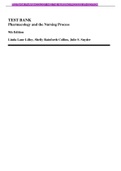Exam (elaborations)
TEST BANK For Health Assessment for Nursing Practice 7th Edition by Susan Fickertt Wilson, Jean Foret Giddens |Complete Chapter 1 - 24 | 100 % Verified
TEST BANK For Health Assessment for Nursing Practice 7th Edition by Susan Fickertt Wilson, Jean Foret Giddens |Complete Chapter 1 - 24 | 100 % Verified TEST BANK For Health Assessment for Nursing Practice 7th Edition by Susan Fickertt Wilson, Jean Foret Giddens |Complete Chapter 1 - 24 | 100 % V...
[Show more]












